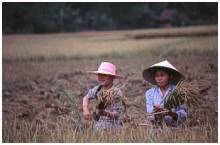Home » Ethnic People » Cho Ro
The Cho Ro People
A Cho Ro House
The Cho Ro have a population of more than 15,000, a large part of them settled in Dong Nai province and the rest in Binh Thuan and Song Be provinces. They are also called Do-ro. The Cho Ro language belongs to the Mon-Khmer Group, close to the Ma and the Xtieng languages.
In the past, the Cho Ro mainly practised slash-and-bum agriculture. They lived a poor and unstable life. Later, they turned burnt-over land into stable cultivable land and in certain places, rice cultivation in submerged fields was developed. Thanks to this, the life of the Cho Ro has been improved. Animal husbandry, hunting, gathering and fishing play an important role in Cho Ro daily life. Basketry and wood carving are their main sideline occupations.
Cho Ro women once wore jupes, the men, loincloths and a shirt pulled over their heads. In winter they covered with a blanket. Of late they have adopted the Kinh style of dress. They are easily recognized however because of the baskets they still carry on their backs and the jewellery worn by the women – necklaces and bracelets made from copper, silver or beads.
Rehearsing Traditional Art Performances
The Cho Ro used to live in houses on stilts with access to the floor by a ladder placed at one end of the house. In recent decades, they have become familiar with living in houses built on the ground. The interior is simple with some gongs and jars which are considered of value. In recent years, many families have bought their bikes.
Both patrilineal and matriarchal customs are significant in Cho Ro family life. In marriage, though the family of the man proposes marriage, the wedding ceremony is always organized at the bride’s house. The man has to come to live in his wife’s house for several years, then they will live in their own separate house.
The Cho Ro bury their dead according to traditional customs. The coffin is a hollowed-out tree trunk. The grave is topped by a semicircular tumulus. Three days after the burial, the ceremony of opening the grave takes place.
The Cho Ro believe that all things have souls and that the spirits have an invisible control over man, which forces him to worship. Most important are the rituals of worshipping the souls of the forest and the rice.
Cho Ro culture is very diverse. Musical instruments comprise a set of seven-pattern gongs, string instruments with bamboo sound-box and alternating songs.


